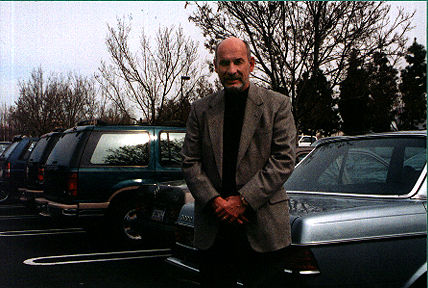March TJKM a Key Role in Sunol Grade Fix
TJKM Plays a Key Role in Sunol Grade Fix

TJKM's Chris D. Kinzel, P.E., has a plan to keep the Sunol Grade from looking any more like this parking lot.
Consultant's Plan Receives $90 Million in State, Federal Funding
Last month, the 680 southbound commute over the Sunol Grade was named the worst commute in the Bay Area by Caltrans. The move to the number one spot has come rapidly by traffic planning standards: In 1994, it ranked just 28th, but shot up to number two the following year.
Thanks in part to a plan developed by Hacienda's TJKM Transportation Consultants, though, relief is on the way. A carpool lane is among the improvements slated for construction beginning in the fall of 2000.
The Thick and Thin of It
TJKM's involvement with the project began in the fall of 1995, when the congestion management agencies (CMAs) of Alameda, Contra Costa, and Santa Clara counties asked the firm to conduct a study to determine a short-term solution to the problem.
"They thought there was going to be an obvious solution, some minor reconstruction and restriping of what in many areas is a wide shoulder," explains Chris D. Kinzel, PE, TJKM's president. "As we got in and studied it, we found that in many areas there is enough room, but the pavement is not of adequate thickness."
A Search for Possibilities
With the possibility of a simple restriping out, the firm began studying the situation to find solutions that would return the most benefit for the least investment.
"We looked at a number of alternatives, including combinations of carpool lanes in different locations and even reversing the lanes with movable barriers, so that you actually travel in the left lane of the northbound lanes as the southbound carpool lane in the mornings, for example," says Kinzel.
Other alternatives studied included ramp metering and the creation of auxiliary lanes on the right side between interchanges.
A Recipe for Relief
The solution, Kinzel believes, actually involves several actions.
"Our recommendation was a combination of things including carpool lanes, some ramp metering, and a little bit of auxiliary lanes," he explains. "We didn't feel that the reversible lanes offered a viable solution because there's too much traffic going in the other direction. Soon, we would have created a similar problem with the northbound traffic."
The plan will take advantage of a number of traffic patterns which already exist on southbound 680.
"Our analysis showed that there are a lot of people that are already carpooling," says Kinzel. "We're confident that it's going to be successful in reducing the congestion significantly and providing a good, quick ride not only for the carpoolers but also for some transit solutions which we recommended."
If commuters continue to stagger their start times as they do now, Kinzel says the improvements would cause congestion to be "virtually eliminated." He thinks that it is unlikely that commuters will continue with early starts to beat the traffic once the improvements are in place, however.
"There will continue to be congestion because people will change the time of their journey, but I think we'll see a change from three-and-a-half hours of congestion to just one hour more like other commutes in the Bay Area," he says.
Footing the Bill
TJKM's recommendations were accepted by the county CMAs, the Metropolitan Transportation Commission, and Caltrans. The issue then became how to pay for the project.
Fortunately for frustrated morning commuters, the funding has come together quickly. State Transportation Improvement Plan (STIP) funds make up $53.7 million of the funding already in place, while CongresswomanEllen Tauscher was able to designate nearly $10 million in federal gas tax funds.
With another $22 million in STIP funds looking solid and another potential $6 million in federal money, a total of $91.45 million should be earmarked for the project.
On the Fast Track
The project's design and environmental work are proceeding simultaneously. Construction is projected to begin in the fall of 2000 and to be completed about a year later.
"It may seem like a long time, but a government usually works in funding cycles of seven or eight years," he says. "For the Sunol Grade, the problem developed in '95, the study started in '97, and by '99 we have a solution targeted and funded, with construction in 2000 it's fast."
The firm's 680-related work isn't finished, either. TJKM is currently working on a related project: a study of possibilities for a cross connector between 680 and 880.
Also in this issue ...
- TJKM Plays a Key Role in Sunol Grade Fix
- Corning Photography Improves on Reality
- Business Bits
- Executive Profile - David Clausen, Clausen Computer Services
- RIDES Offers Cash, Prizes in Earth Day "Alternative Commute" Event
- Don't Get Shaken Up - April is Earthquake Preparedness Month
- Association Offers Free Emergency Procedures Manual to Tenants
- Business Community Input Sought for Pleasanton Youth Master Plan
- Hacienda Index




